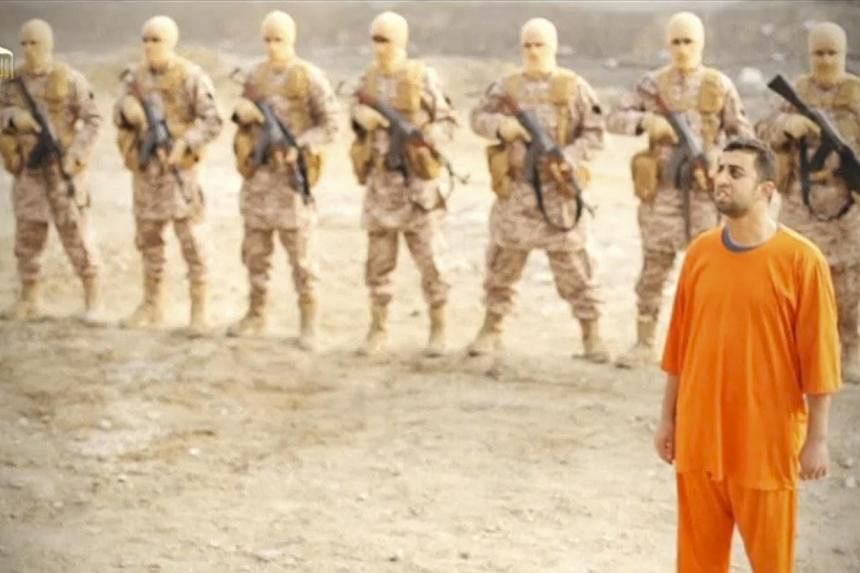How is one to make sense of events, when the Islamic State in Iraq and Syria released a video of a Jordanian pilot Muath al-Kasasbeh burnt alive in a cage, and the video goes viral, attracting worldwide attention?
There is first the visceral human response. Such barbarity and viciousness, says United States President Barack Obama.
Next, incomprehension. Why would ISIS do such a thing? What does it set out to achieve? Does it not realise that such brutality turns people off?
In fact, it could have precisely the opposite effects.
As Aaron David Miller, an American Middle East analyst, writes in a blog on the Wall Street Journal, reproduced here.
"The sheer act of burning a man to death in a cage and the way it was orchestrated on the world stage suggest that Islamic State's objective is to terrorize-regardless of any fear or consequences of backlash.
"ISIS seeks to demoralize those forces arrayed against it, particularly in Syria and Iraq, by demonstrating what happens to those who oppose it.
"The brutal video is designed to recruit sadistic and ideological potential followers who might be motivated by this kind of brutality. The coming weeks will show whether this savage theater bolsters Islamic State's numbers."
Another question in people's minds: ISIS beheaded western hostages, then beheaded a Japanese hostage a few days ago, and a Jordanian this time round. Doesn't Isis have enough enemies? Why widen the net of enmity around it?
As New Yorker staff writer George Packer put it: "The group is running out of high-profile hostages whom it can use to threaten, extort, and terrify the world. (The hundreds of Syrian journalists and activists who disappeared in ISIS territory, the hundreds or thousands of Yazidi women taken into sexual slavery, the tens or hundreds of thousands of ordinary Syrians and Iraqis living against their will under the Islamic State's control-none of them, unfortunately, have much influence over international opinion.)
"So what's the strategy behind the beheadings, other than to lengthen the list of countries that now talk about "their" 9/11? Why would ISIS want to make more enemies than it already has?"
Is the burning a miscalculation by ISIS? Has it gone too far? Will this pit Jordan and other Arab states against ISIS?
Already, there are reports that the murder of the pilot could stiffen Jordan's resolve against ISIS. Says Mr Miller: "Jordan's powerful reaction - including promises of earth-shattering retaliation - is in many respects more meaningful than similar threats from the West. ISIS is a regional problem. Regional ownership in the fight is critical to limiting its expansion. And this fight needs to be joined by Sunnis in an effort to delegitimize the extremists and expose the group for what it is: a corruption and perversion of Islam. The key question now is what other Arab and Muslim states say and do-and whether Lt. Kasasbeh's murder inspires them into a more sustained effort in terms of military participation or through educational and political efforts against ISIS and radical Islam."
But another report in the Guardian says the opposite: that the burning of the pilot will make it harder for King Abdullah of Jordan to continue its involvement in the anti-ISIS coalition. As the Guardian's Middle East Editor Ian Black wrote: "Even before the shock of Kasasbeh's death, opposition to Jordan's anti-Isis role was on the rise. It is hard to see Jordan suddenly withdrawing from the coalition, but the king may become more cautious, while appealing to his people's sense of patriotism and injured national pride."
If the executions are deliberately carried out, and the transmission of the videos carefully planned, what might be the objective?
Here, the New Yorker's Mr Packer attempts an explanation. In an insightful feature written after the beheading of Japanese journalist Kenji Goto but before the burning of the pilot, he recounted how the videotaped beheading of western hostages sickened even some hardened militants:
"Even Al Qaeda admonished Abu Musab al-Zarqawi, the founder of the Islamic State's predecessor organization, Al Qaeda in Iraq, for his nasty habit of beheading hostages on camera. Why not a bullet to the back of the head, Ayman al-Zawahiri helpfully suggested from his hideout in the mountains along the Afghan-Pakistani border? But Zarqawi knew what he was doing, and he kept on, though he's been vastly outperformed by his successors in ISIS.
"The point isn't to use the right level of violence to achieve limited goals. The violence is the point, and the worse the better. The Islamic State doesn't leave thousands of corpses in its wake as a means to an end. Slaughter is its goal-slaughter in the name of higher purification. Mass executions are proof of the Islamic State's profound commitment to its vision."
Won't such brutality turn people off? According to Mr Packer, it attracts: "There's an undeniable attraction in this horror for a number of young people around the Middle East, North Africa, and even Europe and America, who want to leave behind the comfort and safety of normal life for the exaltation of the caliphate. The level of its violence hasn't discouraged new recruits-the numbers keep growing, because extreme violence is part of what makes ISIS so compelling. Last year, Vice News shot a documentary in the Islamic State's de facto capital of Raqqa, Syria, and what was striking in the footage was the happiness on the faces of ISIS followers. They revelled in the solidarity of a common cause undertaken at great personal risk. They are idealists-that's what makes them so dangerous."
If it is true that ISIS aims as much to attract as to terrify with its video-taped executions, then it is easier to understand why ISIS methods of execution keep topping themselves in brutality and for sheer theatricality. Then the executions are acts of theatre, carefully planned for their audience. If so, then social media and the internet become part of their battlefield.
As Alex Krasodomski wrote on The Spectator blog on Feb 3, after the British Army was derided for forming a 1,500-strong social media unit.
"The narrative of war in this century will be shaped by the individuals fighting it. Facebook and Twitter have become powerful weapons, capable of inspiring and demoralising fighters. In the right hands, they might prove to be important tools in the much-maligned battle for 'hearts and minds'. Through its channels, every fighter can document their fight, producing instant-speed, personalised and 'realistic' propaganda. For all the derision, social media is a battlefield: a fight over who gets to write the story of the conflict. It is fought over by millions of people every day. Recognising this is an important first step."
Whether it's a beheading or burning, any execution that is cold-bloodedly filmed on video and disseminated worldwide, is a political act designed to manipulate. Analysts may disagree on just what the objective is. But one thing is for sure: part of the objective of broadcasting such images is to strip the person of his or her humanity, and to reduce him or her to the sum total of the act of execution.
The message is: "There was a human being, a person loved, with a unique personal history. See here he lies, a corpse at our hands. This is what we do to enemies and those against us."
But of course those are lies. The person may be dead but his life, his work, his legacy, his spirit, his memory, remain. He is more than a charred body.
Remember James Foley, the journalist beheaded by Isis last August? His cousin Kelly Foley wrote on Twitter then: "Don't watch the video. Don't share it. That's not how life should be."


